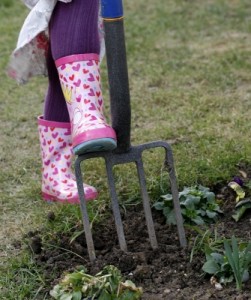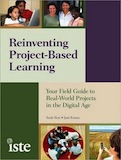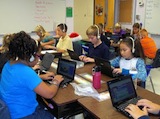 During my year with PLP, I heard Sheryl Nussbaum-Beach talk several times about student-driven, inquiry-based learning. I thought I knew what Sheryl was getting at, but it wasn’t until I took a graduate course this past term on Project Based Learning that I really began to understand all its implications.
During my year with PLP, I heard Sheryl Nussbaum-Beach talk several times about student-driven, inquiry-based learning. I thought I knew what Sheryl was getting at, but it wasn’t until I took a graduate course this past term on Project Based Learning that I really began to understand all its implications.
PBL was never something I spent too much time pondering — just another way to assess learning, right? Instead of a traditional test, I allow my 4th graders to choose a project that demonstrates their learning. Choice is important – by differentiating, students can create something using an area of interest or strength. Incorporate technology? Even better! Got it. I couldn’t imagine what we would do for 14 weeks in this grad class. Simple as 1-2-3.
Well, I didn’t quite “get it.” Turns out PBL is not simply a culminating project at the end of a unit. It’s the learning experience that happens as students attempt to solve a problem or answer a question. For that reason, you will also hear the term “inquiry-based” learning.
If you want to see your K-12 students’ eyes light up with excitement and watch them approach learning with more enthusiasm than ever before, PBL/Inquiry-Based Learning is for you. I encourage you to read on…
PBL Online provides this excellent definition:
Project Based Learning is an instructional approach built upon authentic learning activities that engage student interest and motivation. These activities are designed to answer a question or solve a problem and generally reflect the types of learning and work people do in the everyday world outside the classroom. Project Based Learning is synonymous with learning in depth. A well-designed project provokes students to encounter (and struggle with) the central concepts and principles of a discipline.
Project Based Learning teaches students 21st century skills as well as content. These skills include communication and presentation skills, organization and time management skills, research and inquiry skills, self-assessment and reflection skills, and group participation and leadership skills.
Finally, Project Based Learning allows students to reflect upon their own ideas and opinions, exercise voice and choice, and make decisions that affect project outcomes and the learning process in general.
Combining these considerations, we define Project Based Learning as:
A systematic teaching method that engages students in learning essential knowledge and life-enhancing skills through an extended, student-influenced inquiry process structured around complex, authentic questions and carefully designed products and tasks.
When you ponder all of this, PBL becomes a daunting task! I tore through a fantastic text entitled Reinventing Project-Based Learning: Your Field Guide to Real-World Projects in the Digital Age by Suzie Boss and Jane Krauss. The book is published by ISTE, the International Society for Technology in Education. I highly recommend Boss & Krauss if you’re considering making a commitment to PBL in your classroom.
In my graduate course, my culminating task was to create a PBL unit and implement it in my classroom. Suddenly 14 weeks seemed like nothing!
Fixin’ to Get Ready
A quick note here: Many teachers don’t like PBL because they feel their students don’t work well in groups. This is a significant issue in many classrooms, and is not something that will just “happen.” Students must be taught how to work together. From the beginning of the school year, exercises in active listening, role-playing of conflict resolution and teamwork can help students learn how to function as a group working toward a common goal. In today’s world we are not likely to work in isolation. These are critical skills to be developed and part of becoming a PBL classroom. There are websites that offer activities to help teach team building, constructive criticism, active listening, conflict resolution and to provide general information and activities to support cooperative learning.
The Planning (a Big Deal)
 This heading might need to be in all caps, bold, and 72 point. Planning is the biggest part of a PBL unit. Creating one “on the fly” in the middle of the school year was hazardous to my health. My project was based on a 4th grade Social Studies unit. The students were learning about representative government, and the roles of our three branches. Their mission? To create rules for the school’s common areas (playground, lunchroom, restrooms, etc.). They functioned as the legislative branch, meeting with constituents (students in other classes) and writing the proposed legislation. Our head of school was the executive branch, and had to sign the legislation into law. The teachers were the judicial branch, enforcing the laws once approved. I used a wiki to organize the project and was very happy with that format. Using the format recommended by Boss & Krauss, the project wiki is broken down into these elements:
This heading might need to be in all caps, bold, and 72 point. Planning is the biggest part of a PBL unit. Creating one “on the fly” in the middle of the school year was hazardous to my health. My project was based on a 4th grade Social Studies unit. The students were learning about representative government, and the roles of our three branches. Their mission? To create rules for the school’s common areas (playground, lunchroom, restrooms, etc.). They functioned as the legislative branch, meeting with constituents (students in other classes) and writing the proposed legislation. Our head of school was the executive branch, and had to sign the legislation into law. The teachers were the judicial branch, enforcing the laws once approved. I used a wiki to organize the project and was very happy with that format. Using the format recommended by Boss & Krauss, the project wiki is broken down into these elements:
- The Project Framework. This includes the unit of study, learning objectives, 21st century skills, standards, NETS·S, and learning dispositions that will be covered in your project.
- Evidence of Learning. This covers any projects, presentations, collaborative documents, or individual reflections that students will complete as part of the project.
- Entrée to Project. Here is where you plan how to build student excitement/engagement by providing the relevance and importance of the project, and plan your kick-off event.
- Project Sketch. This is a summary of the project, defining the stages, tasks, items produced by students, and a timeline for the project.
Time is necessary to ensure you have a project that is not too big or small, meets learning objectives, has the necessary rubrics to assess student projects/presentations/reflections, and is scheduled to be completed (preferably) in 3-6 weeks, depending on the size of the unit. If you’re planning to do some Google searches around PBL, a great website to start is the Buck Institute for Education. Their Project Based Learning for the 21st Century section offers information and a search tool to look for projects by subject and grade level.
The Payoff
 Although my first real PBL project was far from perfect, I immediately saw the benefits in my classroom. From day one, my students were chomping at the bit. They would have been totally happy not to worry about any other subjects and just work on their projects all day. I was blown away. The key to this is a sense of importance and meaningful work. There was a real need for the rules they were creating, and they knew they would be implemented and utilized. Therefore they took their job seriously and were excited and motivated by the responsibility of creating something important for the school.
Although my first real PBL project was far from perfect, I immediately saw the benefits in my classroom. From day one, my students were chomping at the bit. They would have been totally happy not to worry about any other subjects and just work on their projects all day. I was blown away. The key to this is a sense of importance and meaningful work. There was a real need for the rules they were creating, and they knew they would be implemented and utilized. Therefore they took their job seriously and were excited and motivated by the responsibility of creating something important for the school.
There were a few bumps along the way. I began by having each group visit every lower school classroom to meet with students and get ideas. This turned out to take a ridiculous amount of time. We modified on the fly and had each group visit three classes. I also had too many elements involved in my project. My decision to have them research rules in other schools, create a list of rules to post, present the rules for the school, establish a Google Doc where all the rules would be put together, and write reflective blog posts was simply too much for my 4th graders. There was no way the project could be completed in time. I definitely got carried away, and in my most recent efforts, I’m learning to limit the scope of my projects and manage my time more effectively.
Even though things can get a little stressful and chaotic in a PBL experience, what makes it all worthwhile is the learning. Students don’t remember the problems or pitfalls, they remember the excitement they felt as they solved a problem, and they remember the lessons (content) they learned while working. Why? It’s what Sheryl promised in those PLP webinars last year: Student-driven PBL projects push students to go deep into the content.
By “going deep” and taking an active role in their own learning, our students retain a great deal more than when we “stand and deliver” and they zone out — wondering how long it is until recess!
Image: Girl digging, Claire Bloomfield, Free Digital Photos
Patti Grayson
Latest posts by Patti Grayson (see all)
- Rethinking Content in the Digital Age - September 4, 2012
- Escape to Summer Reading - June 12, 2012
- Our Skype Adventures: Creating Connected Learners in a Global Classroom - May 29, 2012


What a great summary/intro to PBL, Patti!
You are so right about the planning. This is my first year of implementing inquiry-based learning in my first grade classroom. I feel like I am continuously flying by the seat of my pants. I’m already looking forward to next year when I’ll have a better idea of HOW to plan.
Thanks, Kathy! Love hearing about the great things you do with your students. I agree though – I’ll enjoy getting a second shot at some of these projects (with a little less stress!).
What a great project. I enjoyed reading about the planning and collaboration of so many at your school.
I’m still struggling with the 2 terms, PBL and inquiry learning. I have read that PBL is authentic and works on solving a real life problem which is what you did and wrote about, but I thought inquiry based learning focused more on giving students choices about what they want to learn about. Can you have inquiry based learning without PBL?
It also seems that once you do a PBL unit, you may need a new focus the following year since the problem was already solved. I love doing new things, but when I do something for the first time, I learn so much from my mistakes, and can’t wait to try it again the following year.
I really need to get a better handle on these terms.
Linda – Thanks for your comments! You ask some very good questions. I think PBL and inquiry based learning go hand in hand. There’s also some discussion over whether the P in PBL stands for “project” or “problem”!
An inquiry based learning experience might be: “We want to put a new table in the room for small groups to meet. Can we rearrange our room to fit the table?” Student groups would work on measuring the room and the desks, learn about area (square feet), create a scale and draw the ideas on graph paper, research different room arrangements, discuss the best positions of the desks for learning, etc.
For me this would still incorporate something of a project, as the students would have to draw their ideas and create something that answered the question.
I think no matter what you call it, when we offer students authentic, meaningful, relevant learning experiences, our students become more engaged and excited about learning, and the learning is deeper and longer lasting. A victory by any name!
Patti,
I just loved reading all of that great information about PBL and I always enjoy your frankness about the ups and downs. I am inspired to read and try it for myself! Can’t wait to pick your brain for more information!
Thanks so much.
Heidi